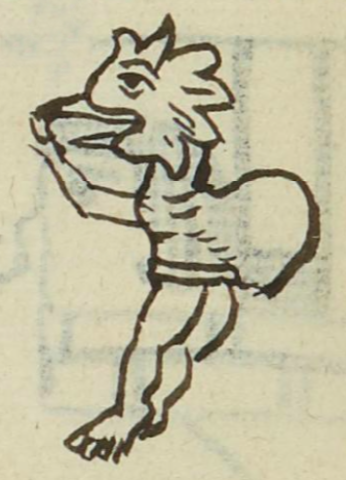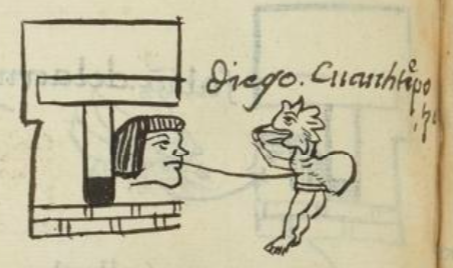Cuauhtepotzo (MH732v)
This black-line drawing of the compound glyph for the personal name, Cuauhtepotzo (perhaps “Pole Latch” or “Lock”), is attested here as a man’s name. It shows the head of an eagle (cuauhtli), which serves as the phonetic indicator for the Cuauh- (here, wooden pole). The eagle’s head is shown in profile, facing toward the viewer’s left. Its eye and beak are open. Below the eagle’s head is what appears to be a human body. The waist band of the loincloth lets the viewer know that this is a man. He has a large lump (hunchback, tepotzotli) on his back. The hatching where the lump meets his back provides some three-dimensionality. The hunchback is also a phonetic indicator for the second part of the term cuauhtepotzotli, a lock or a latch on a post.
Stephanie Wood
1560
Jeff Haskett-Wood
cerradura de palo, pestillo, madera, águilas, jorobado, nombres de hombres

cuauhtepotzo(tli), a lock or a latch on a post, https://nahuatl.wired-humanities.org/content/cuauhtepotzotli
tepotzo(tli), a hunchback, https://nahuatl.wired-humanities.org/content/tepotzotli
cuauh(tli), eagle, https://nahuatl.wired-humanities.org/content/cuauhtli
cuahui(tl), tree, wood, https://nahuatl.wired-humanities.org/content/cuahuitl
posiblemente, Cerradura de Palo
Stephanie Wood
Matrícula de Huexotzinco, folio 732v, World Digital Library, https://www.loc.gov/resource/gdcwdl.wdl_15282/?sp=543&st=image
This manuscript is hosted by the Library of Congress and the World Digital Library; used here with the Creative Commons, “Attribution-NonCommercial-ShareAlike 3.0 License” (CC-BY-NC-SAq 3.0).




